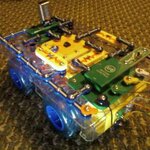Applied Physics

Silicon has been very good to us. It has given us Angry Birds and virtual protests we can participate in from the comfort of our home, but it may be time to enter the Age of the Biological Computer.
Writing in the journal Materials Today,researchers reveal details of logic units built using living slime molds, which might act as the building blocks for computing devices and sensors.
You're more likely to find the slime mold Physarum polycephalum living somewhere dark and damp rather than in a computer science lab. In its "plasmodium" or vegetative state, the organism spans its environment…

http://kids.discovery.com/activities/science-experiments/light-up-lifesa...
wintergreen oil in the candy, the ultraviolet light is simply converted to a more visible type

In honor of the upcoming National Robotics Week (April 5-13, 2014), I’ve created “CockroachBot” based on my Snap Circuits programmable robot I designed for last year’s robotics week. CockroachBot will try to run away when it detects a particular level of light falling on its light dependent resistor. I designed CockroachBot to be easy to build completely out of Snap Circuits parts and easy to program to inspire folks from seven to centenarian to get interested in robotics.
Parts Needed:
1 10 X 10 Plastic Base Grid
1 Rover
1 9 volt Battery Block B5
1 Motor Control IC U8
1 8 Pin…

Revelations of the extent of American government surveillance into the private lives of both the American public and foreign leaders worldwide has shone a spotlight on the lack of security in digital communications.
Even today's encrypted data is vulnerable but physics may come to the rescue, according to a Nature article by Artur Ekert and Renato Renner ("The ultimate physical limits of privacy", doi:10.1038/nature13132).
Secrets and spying have always been in an arms race. The most brilliant efforts of code-makers have been matched time and again by the ingenuity of code-breakers and…

Our bones are a matrix of minerals and other substances, including living cells, though most people don't think of them that way and assume bones are 'natural' — but nature can be coaxed to do all kinds of things.
MIT engineers have coaxed bacterial cells to produce biofilms that can incorporate nonliving materials, such as gold nanoparticles and quantum dots. These "living materials" combine the advantages of live cells, which respond to their environment, produce complex biological molecules, and span multiple length scales, with the benefits of nonliving materials, but they add…

Collectors,museums and art dealers face a lot of problems determining origin, authenticity and discovery of forgery of artwork. Experts are easily fooled - but science, not so much.
They get help through the application of modern, non-destructive, "hi-tech" techniques. Spectroscopy is a technique that has been useful in the fight against art fraud because it can determine chemical composition of pigments and binders, which is essential information in the hands of an art specialist in revealing fakes. As described in a recent paper, "…according to the FBI, the value of art fraud,…
There’s a popular YouTube video featuring mathematician Edward Frenkel where he describes how the NSA hacked our emails. It is a backdoor into the National Institute of Standards and Technology public key encryption standards.
I’ll borrow an analogy for a simplified description of how public key encryption works from Simon Singh. Imagine a sturdy metal box that can be locked shut with a padlock. Let’s say Alice wants to send a message to Bob and she wants no one but Bob to read her message (descriptions of encryption systems traditionally use “Bob and Alice”). Bob buys a padlock from the…

By now, almost everyone understands computers and that current technologies for writing, storing, and reading information are either charge-based or spin-based.
Spin-based devices operate on the principle that in materials like iron, electron spins generate magnetism and the position of the north and south pole of the magnet can be used to store the zeros and ones. This technology is behind both magnetic stripe cards and terabyte computer hard disks. Since these devices are based on spin, they are more robust against charge perturbations but the drawback is that in order to reverse the north…

In my previous article DC Versus AC I discussed how a diode can be used as a rectifier to convert alternating current (AC) into direct current (DC) because the diode allows current to flow in one direction, but not the other.
The diode is the simplest semiconductor electronic component, but the physics of how they work is perhaps somewhat complicated. There are many resources available on the web such as the Edison Tech Center semiconductor resource page.
Diodes can be made from household items such as a point contact diode made from a razor blade and a pencil used in a foxhole radio.…

New battery management technology could boost Li-ion capacity by 40%, quadruple recharging cycles
Long-life laptop battery the tech industry doesn’t want you to have ?
Fed up with the dwindling battery life of his BlackBerry Bold 9000,
Carleton University chemistry student Tim Sherstyuk took a
straightforward problem to his electrical engineer dad, Nick: Could the
two of them come up with the technology to make a standard lithium-ion
battery last longer?...After a year of trial and error, the Ottawa-based father-son duo hit an
engineering bull’s-eye. By pairing batteries with their own…